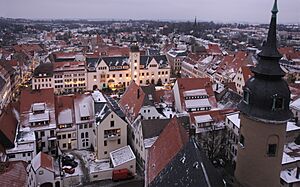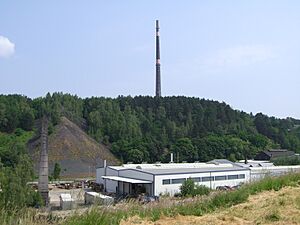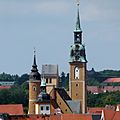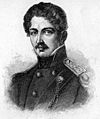Freiberg facts for kids
Quick facts for kids
Freiberg
|
||
|---|---|---|

Freiberg with Peter's Church in December 2007
|
||
|
||
| Country | Germany | |
| State | Saxony | |
| District | Mittelsachsen | |
| Elevation | 400 m (1,300 ft) | |
| Population
(2022-12-31)
|
||
| • Total | 40,485 | |
| Time zone | CET/CEST (UTC+1/+2) | |
| Postal codes |
09599, 09596
|
|
| Dialling codes | 03731 | |
| Vehicle registration | FG | |
| Website | www.freiberg.de | |
Freiberg is a historic city in Saxony, Germany. It is famous for its university and its past as a mining town. Freiberg is also the main city of the Mittelsachsen district.
The old part of Freiberg is very special. It is protected as a heritage site. It is also part of a UNESCO World Heritage Site called the Ore Mountain Mining Region. This is because it shows how mining methods developed over many centuries. For about 800 years, until 1969, mining and metal production were the most important industries here. Today, Freiberg is a center for high technology. It focuses on making parts for computers and solar technology. This area is even called Silicon Saxony. Freiberg is also home to the oldest mining and metal-making university in the world. It is called the Freiberg University of Mining and Technology.
Contents
Geography
Where is Freiberg Located?
Freiberg is on the northern side of the Ore Mountains. Most of the city is west of the Eastern or Freiberger Mulde river. Parts of the city are in the valleys of the Münzbach and Goldbach streams. The city center is about 412 meters (1,352 feet) above sea level.
The area around Freiberg was once covered by forests. Later, the mining industry changed the landscape. Today, woods surround the city to the north, southeast, and southwest. Other areas have fields and meadows. Freiberg is part of a growing urban area with nearby towns. This area has about 75,000 people.
Freiberg is about 31 kilometers (19 miles) west-southwest of Dresden. It is also about 31 kilometers (19 miles) east-northeast of Chemnitz. Leipzig is about 82 kilometers (51 miles) to the southeast. Berlin is about 179 kilometers (111 miles) south. Prague is about 120 kilometers (75 miles) northwest.
How the Town Grew
The very first part of Freiberg was a small village called Christiansdorf. It was in the Münzbach stream valley. The main part of the city grew on the slopes and a ridge to the west. This means some roads going east are very steep.
The area east of the main road is called Unterstadt (Lower Town). It has the lower market, Untermarkt. The western area is the Oberstadt (Upper Town). This is where the Obermarkt (Upper Market) is located. A green area runs around the old city center. This area follows where the old city wall used to be.
To the north of the city center is Freudenstein Castle. You can still see parts of the old city wall and some towers. The B 101 and B 173 federal roads run along the edges of the city center.
Surrounding Areas
Around Freiberg, you can find industrial areas and places for farming and recreation. Companies that work with metal are in Muldenhütten and Halsbrücke. Paper factories are in Weißenborn and Großschirma. To the northeast of the city is the Tharandt Forest, a popular place for outdoor activities.
The town of Großschirma is north of Freiberg. To the northeast, the municipality of Halsbrücke is next to Freiberg. To the east is Bobritzsch-Hilbersdorf. The municipality of Weißenborn is to the southeast. South of Freiberg is the city of Brand-Erbisdorf. To the east is Oberschöna.
History
![]() Margraviate of Meissen 1186–1423
Margraviate of Meissen 1186–1423
![]() Electorate of Saxony 1423–1806
Electorate of Saxony 1423–1806
![]() Kingdom of Saxony 1806–1871
Kingdom of Saxony 1806–1871
![]() German Empire 1871–1918
German Empire 1871–1918
![]() Weimar Republic 1918–1933
Weimar Republic 1918–1933
![]() Nazi Germany 1933–1945
Nazi Germany 1933–1945
![]() Allied-occupied Germany 1945–1949
Allied-occupied Germany 1945–1949
![]() German Democratic Republic 1949–1990
German Democratic Republic 1949–1990
![]() Germany 1990–present
Germany 1990–present
Freiberg was founded around 1168. This happened after silver was discovered, which led to a "silver rush." For centuries, Freiberg was a major center for mining in the Ore Mountains. A key part of this history is the Freiberg University of Mining and Technology. It was started in 1765 and is the oldest mining and metal-making university still open today.
Freiberg also has a beautiful Freiberg Cathedral. Inside, you can find two famous organs made by Gottfried Silbermann. There are two other Silbermann organs in the city. One is in St. Peter's Church (Petrikirche), and the other is in St. James' Church (Jakobikirche).
A big fire destroyed much of Freiberg in 1484. After that, the city was rebuilt in the Renaissance style. This part of the city is now protected as a heritage site.
Silver mining stopped in 1913 because silver prices dropped. Mining started again before World War II. People mined for lead, zinc, and tin until 1969.
During World War II, a camp was built outside Freiberg. It was a place where many women were held. These women had survived other difficult situations. The camp was evacuated in April 1945.
In 1985, The Church of Jesus Christ of Latter-day Saints built the Freiberg Germany Temple here. This was a very important event for church members. The temple serves members from all over Eastern Germany and much of Eastern Europe.
On July 6, 2019, the Ore Mountains/Krušnohoří Mining Region, including Freiberg, became a UNESCO World Heritage Site. This means it is recognized as a place of great importance to the world.
Regular Events
Every year in Freiberg, the Mining Town Festival (Bergstadtfest) takes place. It is held on the last weekend of June. A parade by the historic Miners' and Ironworkers' Guilds is a highlight. This parade is called the Miners' and Ironworkers' Parade.
The Freiberg Christmas Market happens during Advent. During this time, a traditional Mettenschicht is held. This includes another parade by the Miners' and Ironworkers' Guilds. It also features the SAXONIA Miners Music Corps. A traditional Sermon on the Mount is given in St. Peter's Church.
Another regular event is the potter's gathering. It happens on a weekend in April on the Upper Market (Obermarkt). There is also a model steam engine gathering every year. This takes place at the Drei Brüder Schacht mineshaft. Other annual events include the Freiberg Art Award. The city also elects a Mining Town Queen (Bergstadt-Königin).
Education
The Technische Universität Bergakademie Freiberg is a very old and important university. It is also known as the Freiberg Mining Academy. It was founded in 1765. Prince Franz Xaver, who ruled Saxony, started it. This university is the oldest mining and metallurgy university in the world.
Twin Towns – Sister Cities
Freiberg has special friendships with other cities around the world. These are called twin towns or sister cities:
Freemen
- 2000 Günter Blobel, a biochemist who won the Nobel Prize in 1999.
- 2014 Michael Federmann, an investor.
Notable People
Many famous people have lived in or are connected to Freiberg.
- August Bebel (1840–1913), a well-known politician.
- Fritz Bleyl (1880–1966), an architect and painter.
- Günter Blobel (born 1936), a biologist and Nobel Prize winner. He helped rebuild old buildings in Saxony.
- Theodoric of Freiberg (around 1250–1311), a thinker who explained the rainbow.
- Johann Wolfgang von Goethe (1749–1832), a famous writer and scientist.
- Alexander von Humboldt (1769–1859), a famous naturalist and explorer.
- Theodor Körner (author) (1791–1813), a poet and freedom fighter.
- Friedrich Mohs (1773–1839), a mineralogist who created the Mohs hardness scale.
- Novalis (1772–1801), a famous poet.
- Clara Schumann (1819–1896), a very talented pianist.
- Gottfried Silbermann (1683–1753), a master organ builder.
- André Tanneberger (born 1973), known as ATB, a popular trance DJ.
- Clemens Winkler (1838–1904), a chemist who discovered the element germanium.
Images for kids
-
The electoral box of the Polish king Augustus II the Strong in the Freiberg Cathedral
See also
 In Spanish: Freiberg (Sajonia) para niños
In Spanish: Freiberg (Sajonia) para niños















